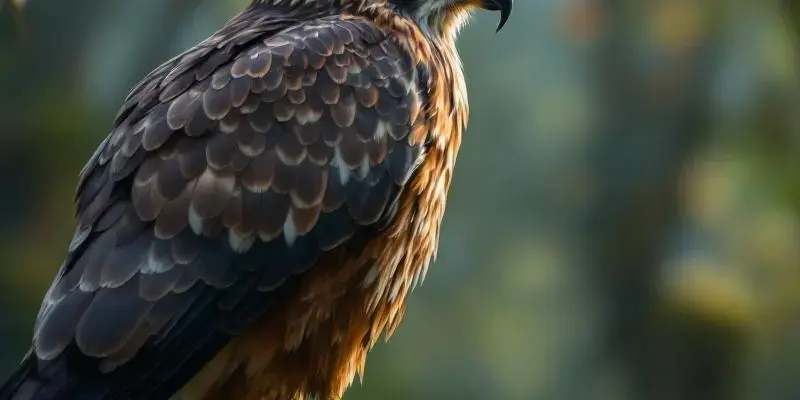Harpy-eagle spiritual meaning

The harpy eagle, with its imposing presence and near-mythical status, carries profound spiritual significance as a messenger between earthly and divine realms. Its rare appearance and extraordinary physical abilities have inspired spiritual interpretations across cultures, representing power, precision, and the delicate balance between independence and interdependence.
Key Takeaways
- The harpy eagle symbolizes the bridge between physical and spiritual worlds
- Named after Greek mythology’s harpies, this bird holds sacred significance in multiple ancient cultures
- As a spirit animal, it teaches lessons about interdependence and partnership
- The eagle’s physical traits mirror its spiritual attributes of strength and precision
- Conservation of this threatened species represents a spiritual responsibility to protect what we honor
The Majestic Messenger of the Rainforest
The harpy eagle (Harpia harpyja) stands as one of the world’s most powerful and impressive raptors, making its home primarily in the rainforests of Central and South America. With 93% of its distribution concentrated in the increasingly threatened Amazon region, this magnificent bird has become increasingly rare, enhancing its mystical significance. Currently listed as Near Threatened on the IUCN Red List, the harpy eagle’s elusive nature and declining population have only added to its spiritual mystique.
Indigenous peoples and spiritual traditions have long viewed the harpy eagle as a sacred intermediary between the physical and spiritual domains. Its commanding presence in the upper canopy of rainforests places it literally between earth and sky, a position that mirrors its symbolic role as a bridge between worlds. The bird’s ability to move between these realms with grace and power makes it a natural spiritual messenger in many traditions.
The Embodiment of Power: Physical Traits and Spiritual Symbolism
The physical characteristics of the harpy eagle directly inform its spiritual symbolism. Measuring 89-102 cm in body length with a massive 2-meter wingspan, these birds command attention. Females typically weigh 7-9 kg while males range from 5-8 kg, making them among the heaviest eagles in the world. Perhaps most impressive are their talons, reaching up to 12.5 cm long—comparable to the claws of a grizzly bear.
Despite their substantial size, harpy eagles possess the remarkable ability to fly silently through dense forest, a trait that connects to their spiritual association with stealth and precision. This ability to move undetected while maintaining awareness reflects the spiritual teaching of mindful presence. Their low population density (only 3-6 nests per 100 km²) further emphasizes their special status as rare messengers.
In spiritual interpretation, these physical attributes translate directly into symbolic meanings. The eagle’s strength represents spiritual fortitude and resilience, while its precise hunting ability suggests focused intention and clarity of purpose. The keen eyesight that allows it to spot prey through dense canopy symbolizes spiritual insight and the ability to see truth beyond illusion.
Ancient Connections: Mythology and Cultural Significance
The harpy eagle’s name derives from the harpies of Greek mythology—fierce wind spirits depicted with female faces and bird bodies. These mythological beings were seen as agents of divine justice, snatching away those who violated sacred laws. This connection to judgment and justice carries through in some spiritual interpretations of the harpy eagle as a symbol of karmic balance.
In Mesoamerican traditions, particularly among Aztec civilizations, the harpy eagle held sacred associations with Quetzalcoatl, the feathered serpent deity. The bird’s impressive appearance and rare sightings contributed to its status as a messenger of the gods. Modern pop culture has also drawn inspiration from this majestic creature, with Fawkes the phoenix in the Harry Potter series reportedly based on harpy eagle appearance.
The national significance of the harpy eagle is particularly evident in Panama, where it has been the national bird since 2002 and features prominently in the country’s coat of arms. Across multiple cultures and time periods, the harpy eagle consistently emerges as a symbol of power, divine connection, and spiritual authority.
Spiritual Wisdom and Modern Interpretations
At the core of harpy eagle spiritual teaching lies the principle of “Interdependence and Partnership”—a reminder not to isolate ourselves even when we possess great personal strength. The eagle’s connection to the “Spirit of Wind” represents freedom and transcendence, encouraging spiritual seekers to rise above limitations while maintaining connections to community.
Many modern spiritual practitioners work with the harpy eagle as a power animal or spirit guide. These encounters may occur through dreams, meditation, or rare physical sightings, each considered a significant spiritual message. The guidance received typically focuses on balancing independence with connection—a central teaching of harpy eagle wisdom.
The relationship between the bird’s physical characteristics and spiritual lessons offers practical wisdom. Its massive talons teach about knowing when to grasp tightly and when to release, while its keen eyesight represents the development of spiritual discernment and clarity. Like the raven in spiritual traditions, the harpy eagle serves as both messenger and teacher.
Conservation Crisis and Spiritual Imperative
The harpy eagle faces a conservation crisis that carries spiritual implications. Current estimates suggest a 41% reduction in its distribution range from IUCN assessments, with habitat loss through deforestation as the primary threat. The bird’s slow breeding cycle—producing only one chick every 2.5-3 years—makes population recovery particularly challenging.
Direct hunting poses another significant threat, with gunshots identified as the leading cause of adult mortality. Conservation efforts have identified northern South America and Panama as critical “climatically stable refugia” essential for the species’ survival. These protected areas represent not just ecological necessity but spiritual sanctuary.
From a spiritual perspective, the conservation of harpy eagles represents a sacred responsibility. Many traditions teach that what we honor spiritually, we must also protect physically. This connection between spiritual reverence and conservation action offers a powerful framework for environmental ethics, suggesting that our spiritual relationship with this magnificent bird carries obligations for its protection.
Practical Applications: Working with Harpy Eagle Energy
For those drawn to harpy eagle energy, several practical methods can facilitate connection. These include direct nature observation where possible, using oracle cards featuring the bird, conducting research, and dedicated meditation practices focused on the eagle’s qualities. Each approach offers different pathways to accessing the spiritual wisdom this magnificent creature embodies.
Interpreting harpy eagle appearances—whether in dreams, synchronistic encounters, or meditation—requires attention to context and personal circumstances. Generally, such appearances suggest a need to balance independence with community connection, or may indicate a call to develop greater precision and awareness in everyday life.
Some practitioners create a dedicated harpy eagle altar using symbolic elements that represent aspects of the bird’s energy. These might include:
- Feathers (ethically sourced) representing connection to air element
- Stones or crystals in earth tones reflecting the eagle’s forest home
- Water element to symbolize emotional fluidity and adaptability
- Images or artistic representations of the harpy eagle
Regional Significance and Indigenous Knowledge
The harpy eagle’s distribution spans from southern Mexico to northern Argentina, with each region developing distinct cultural interpretations based on local relationships with the species. Specific conservation zones such as the Reserva Ecológica Mache Chindul and Reserva Ecológica Cotacachi Cayapas protect crucial habitat while also preserving the cultural heritage connected to the eagle.
Indigenous territories, particularly the Chachi and Awa lands, maintain traditional spiritual knowledge about the harpy eagle that offers valuable insight into sustainable relationship with the natural world. In these traditions, the eagle often represents a guardian spirit protecting forest integrity and ecological balance.
The bird’s near extinction in Central America due to extensive logging of Mesoamerican rainforests has created spiritual as well as ecological loss. Many indigenous communities view this decline as both physical and spiritual impoverishment, reflecting the intricate connection between biological diversity and cultural wisdom. Regional variations in harpy eagle spiritual interpretations remind us that spiritual meaning always exists within specific ecological and cultural contexts.
The article explores the spiritual significance of harpy eagles as messengers between earthly and divine realms. These powerful raptors, primarily found in Central and South American rainforests, symbolize strength, precision, and balance between independence and interdependence. They’re named after Greek mythology’s harpies and hold sacred significance across various cultures. Their impressive physical traits (2-meter wingspan, bear-like talons) mirror their spiritual attributes. Conservation efforts for these threatened birds represent both ecological necessity and spiritual responsibility. The harpy eagle teaches spiritual lessons about balanced relationships and serves as a powerful spirit animal for those seeking connection through meditation, nature observation, and dedicated altars.
| Key Aspect | Significance |
|---|---|
| Symbolic Role | Bridge between physical and spiritual worlds |
| Cultural Meaning | Sacred messenger in indigenous traditions and national symbol (Panama) |
| Spiritual Lessons | Balance between independence and community connection |
| Conservation Status | Near Threatened with 41% habitat reduction; represents spiritual responsibility |














